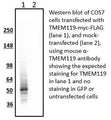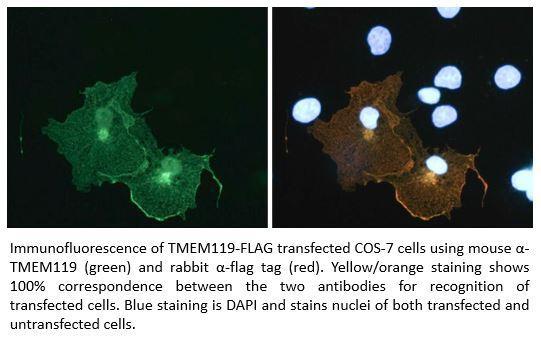Anti-TMEM119 Antibody (L128/43)
Our Anti-TMEM119, OBIF mouse monoclonal primary antibody from NeuroMab is produced in-house from hybridoma clone L128/43. It detects mouse TMEM119, OBIF, and is purified by Protein A chromatography. It is great for use in IHC, ICC, WB.
Mouse
ELISA, ICC, IHC, WB
Mouse
SKU: 75-512
Ships: 1-2 business days
Product Details
TMEM119, OBIF
TMEM119, is a plasma membrane protein first identified because of its role in the differentiation of osteoblasts (Kanamoto et al., 2009). However TMEM119 is also known to be a specific marker of microglia, the tissue-resident macrophages of brain and spinal cord (Bennett et al., 2016). Unlike other microglia markers, TMEM119 expression readily distinguishes resident microglia from blood-derived macrophages, making it a highly specific microglia marker. In healthy brain microglia are the resident immune cells where they act to neutralize pathogens, clear dead and dying cells, and prune synaptic connections. However, in neurodegenerative disease microglia can actually promote neuronal degeneration through reduced phagocytic clearance and increased pro-inflammatory effects. Our anti-TMEM119 antibody is a highly specific microglial marker for mouse TMEM119 and works by western blot and immunocytochemistry.
Purified by Protein A chromatography
1 mg/mL
Monoclonal
L128/43
IgG1
ELISA, ICC, IHC, WB
Mouse
TMEM119
30 kDa
Fusion protein amino acids 113-280 (cytoplasmic C-terminus) of mouse Tmem119
Mouse
Mouse
AB_2927661
Aliquot and store at ≤ -20°C for long term storage. For short term storage, store at 2-8°C. For maximum recovery of product, centrifuge the vial prior to removing the cap.
Liquid
Produced by in vitro bioreactor culture of hybridoma line followed by Protein A affinity chromatography. Purified mAbs are >90% specific antibody.
10 mM Tris, 50 mM Sodium Chloride, 0.065% Sodium Azide pH 7.125
Unconjugated
No cross-reactivity reported
Each new lot of this antibody is tested to confirm that it shows the expected staining pattern when used to stain COS cells overexpressing target.
These antibodies are to be used as research laboratory reagents and are not for use as diagnostic or therapeutic reagents in humans.
United States
24 months from date of receipt
TMEM119, OBIF
Shipped on ice packs




